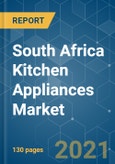The Kitchen Appliance Market in South Africa is showing a low growth rate for over a couple of years. Fluctuating consumer sentiment, a slowly growing economy has contributed to stagnant industry revenue over time. The increasing urbanization rate in South Africa is taken as one of the drivers for the growing kitchen appliance market. In 2020 67.35% percent of South Africa's total population lived in urban areas and cities while the urbanization rate was only 65% in 2015. Demand for the kitchen appliance product is sensitive to movement in real household discretionary income. When the average household discretionary income is high, consumers tend to spend more on appliances. The disposable income of South Africa in 2019 was 34,037 South African Rand. The Kitchen Appliance market is also related to real estate and the number of households. The developed real estate market translates into higher demand for the kitchen and the household appliances as owner or the tenant of the new building require appliances for their daily need. The current number of households in South Africa is 17.16 million.
The Covid-19 has resulted in a significant negative impact on sales due to retail shutdowns as retail showrooms and stores are the predominant distribution channel for kitchen appliances. The economy is slowly reviving after the pandemic and sales of kitchen appliances have gain momentum especially small kitchen appliances that have shown a rapid increase in demand.
Key Market Trends
Low Appliance Penetration Rate in South Africa Signifies a Large Untapped Market
Compared to other developed countries, the penetration rate of household appliances in South Africa is relatively low. Hence, South Africa has great potential in the household appliance market. The penetration rate of basics household appliances in South Africa in urban areas is higher compared to the other small cities. While this indicates that households in these areas will be a major growth market for this industry. it is anticipated that demand for replacing appliances will also be a driver of growth in urban areas of South Africa so, the focus for the urban area will be on replacing current appliances, while in lower-tier cities it will be first-time purchases.
Online Sales of Kitchen Appliances are Gaining Momentum with the Pandemic
The offline retail distribution channel was the dominant channel for kitchen appliance distribution. Due to the pandemic physical distribution channel were shut off at the same time the online sales of small kitchen appliances such as electric kettles, toasters, blenders increased. Sales of appliances addressing the new challenges generated by the enforced need to “eat at home”, “clean at home” raises the online sales of appliances such as refrigerators, microwave ovens, and dishwashers. With the lockdown as people stockpiled (frozen) food, the immediate need for more storage capacity boosted online sales of freezers. Increased internet penetration rate also resulted in higher online sales of appliances. There were 38.19 million internet users in South Africa in January 2021. The number of internet users in South Africa increased by 1.7 million (+4.5%) between 2020 and 2021
Competitive Landscape
The South Africa Kitchen Appliances market is fragmented with many players operating in the market. Many international players have their presence in the kitchen appliance market of South Africa. Major players include Defy Appliances, Samsung Electronics, Electrolux, LG Electronics, Haier Group, Miele, Hisense, Smeg, and KIC.
Additional Benefits:
- The market estimate (ME) sheet in Excel format
- 3 months of analyst support
This product will be delivered within 2 business days.
Table of Contents
Companies Mentioned (Partial List)
A selection of companies mentioned in this report includes, but is not limited to:
- Defy Appliances
- Samsung Electronics
- Electrolux
- LG Electronics
- Haier Group
- Miele
- Hisense
- Smeg
- KIC
Methodology

LOADING...








